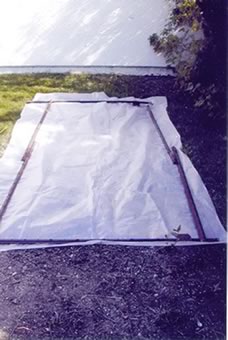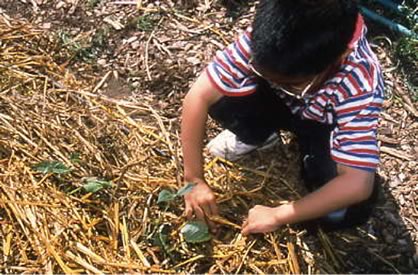|
Methods of Control Some nonchemical methods of weed control are: cultivation, proper site preparation, solarization, mulching, and preventive seed production.
Place a sheet of clear plastic one to four millimeters in thickness over the area. The plastic must lie very close to the soil surface as this maximizes the high soil temperatures necessary to kill seeds. Anchor the edge of the tarp by burying it in a small soil trench around the plot. Be sure to repair any rips in the plastic to insure an air-tight cover and maintain maximum soil temperatures. Soil solarization should be done during the summer months to best utilize the high temperatures and high light intensities. Wait three to four weeks while the sun heats the soil and roasts the weed seeds. Remove the plastic and allow the soil to dry slightly before planting. Do not cultivate soil deeply as this will bring more viable weed seeds to the surface.
Materials high in organic content may reduce the nitrogen available to plants as these materials will require nitrogen during the decaying process. Apply about 2 pounds of a nitrogen fertilizer (such as ammonium sulfate) per 100 square feet prior to mulching. This will ensure that adequate nitrogen will be available to the mulch and crops. If the ammonium sulfate is applied on top of the mulch, much of the beneficial nitrogen will evaporate into the air. Organic mulches can be tilled under periodically to improve the condition of the soil. Black plastic film, newspapers, and other such materials can also serve as mulches. They provide the same functions as organic mulches, but they do not offer the soil conditioning potential of the organics. Black plastic can be placed on the soil and properly anchored against wind immediately after the soil is prepared for planting. Transplants can then be set through the plastic by cutting holes just large enough for the plant to fit through. |

